Petrogenesis and Tectonic Implications of the Early–Middle Ordovician Granodiorites in the Yaogou Area of the North Qilian Orogenic Belt
Abstract
1. Introduction
2. Geological Setting
3. Analytical Methods
4. Results
4.1. Zircon U–Pb Dating and Lu–Hf Isotopes
4.2. Whole-Rock Geochemistry
4.3. Mineral Chemistry
5. Discussion
5.1. Petrogenetic Classification
5.2. Petrogenesis
5.2.1. Nature of the Source
5.2.2. Magmatic Evolution
5.3. Implications for Tectonic Evolution
6. Conclusions
- (1)
- New geochronological data for the Yaogou granodiorites were emplaced around 473–460 Ma.
- (2)
- The Yaogou granodiorites originated through the partial melting of ancient continental crust within a subduction-related magmatism.
- (3)
- Our findings support a northward subduction model of the North Qilian Ocean beneath the Alxa Block.
- (4)
- The Yaogou granodiorites formation is likely the result of a reversal in subduction polarity, driven by the inability of the North Qilian oceanic crust to subduct southward.
Supplementary Materials
Author Contributions
Funding
Data Availability Statement
Acknowledgments
Conflicts of Interest
References
- Soesoo, A.; Bons, P.D.; Gray, D.R.; Foster, D.A. Divergent double subduction: Tectonic and petrologic consequences. Geology 1998, 25, 755–758. [Google Scholar] [CrossRef]
- Santosh, M. Assembling North China Craton within the Columbia supercontinent: The role of double–sided subduction. Precambrian Res. 2010, 178, 149–167. [Google Scholar] [CrossRef]
- Holt, A.F.; Royden, L.H.; Becker, T.W. The Dynamics of Double Slab Subduction. Geophys. J. Int. 2017, 209, 250–265. [Google Scholar] [CrossRef]
- Ritabrata, D.; Nibir, M. Role of double–subduction dynamics in the topographic evolution of the Sunda Plate. Geophys. J. Int. 2022, 230, 696–713. [Google Scholar]
- Li, L.S.; Capitanio, F.A.; Cawood, P.A.; Wu, B.J.; Zhai, M.G.; Wang, X.L. Double subduction controls on long–lived continental tectonics and subcontinental mantle temperatures. Geology 2024, 52, 5. [Google Scholar] [CrossRef]
- Barker, P.F.; Hill, I.A. Asymmetric spreading in back–arc basins. Nature 1980, 285, 652–654. [Google Scholar] [CrossRef]
- Gaina, C. Ridge Jumps and Mantle Exhumation in Back–Arc Basins. Geosciences 2021, 11, 475. [Google Scholar] [CrossRef]
- Ficini, E.; Cuffaro, M.; Doglioni, C.; Gerya, T. Variable plate kinematics promotes changes in back–arc deformation regime along the north–eastern Eurasia plate boundary. Sci. Rep. 2024, 14, 7220. [Google Scholar] [CrossRef]
- Xiao, Y.; Liu, X.; Xiao, W.; Gong, X.H.; Wu, H.; Song, Y.; Zhang, Z.; Liu, P. Hot subduction in the southern Paleo–Asian Ocean: Insights from clinopyroxene chemistry and Sr–Nd–Hf–Pb isotopes of Carboniferous volcanics in West Junggar. Geosci. Front. 2024, 15, 101716. [Google Scholar] [CrossRef]
- Tan, X.M.; Gao, R.; Zhou, J.B.; Wilde, S.A.; Hou, H.S.; Wang, H.Y.; Qi, R.; Li, W.H. Fossil divergent double–subduction zone in the Great Xing’an Range, NE China: Evidence from a deep seismic reflection profile. GSA Bull. 2023, 135, 2961–2970. [Google Scholar] [CrossRef]
- Wu, C.l.; Yao, S.Z.; Yang, J.S.; Zeng, L.S.; Chen, S.Y.; Li, H.B.; Qi, X.X.; Joseph, L.W.; Frank, K.M. Double subduction of the Early Paleozoic North Qilian oceanic plate: Evidence from granites in the central segment of North Qilian, NW China. Geol. China 2006, 33, 1197–1208, (In Chinese with English abstract). [Google Scholar]
- Wu, C.L.; Xu, X.Y.; Gao, Q.M.; Li, X.M.; Lei, M.; Gao, Y.H.; Frost, R.B.; Wooden, J.L. Early Palaezoic grranitoid magmatism and tectonic evolution in North Qilian, NW China. Acta Petrol. Sin. 2010, 26, 1027–1044. [Google Scholar]
- Song, S.G.; Niu, Y.L.; Su, L.; Xia, X.H. Tectonics of the North Qilian orogen, NW China. Gondwana Res. 2013, 23, 1378–1401. [Google Scholar] [CrossRef]
- Yang, F.; Xue, F.; Santosh, M.; Qian, Z.; Zhang, C.; Tu, J. Petrogenesis and tectonic evolution of the Palaeozoic to Mesozoic Niuxinshan granitoids in the North Qilian orogen, NW China. Geol. J. 2021, 56, 3207–3224. [Google Scholar] [CrossRef]
- Qin, Z.W.; Wu, Y.B.; Siebel, W.; Wang, H.; Fu, J.M.; Lu, Y.Y.; Shan, L.; Yu, Y.S. Source nature and magma evolution of I–type granites from the North Qinling orogen, China, revealed by zircon morphology and grain–scale variations in Hf[sbnd]O isotope composition. Lithos 2022, 428–429, 106819. [Google Scholar] [CrossRef]
- Xue, F.; Yang, F.; Ren, W.; Santosh, M.; Qian, Z.; Huang, Y.; Tan, Z. Petrogenesis of the Early Paleozoic Dioritic–Granitic Magmatism in the Eastern North Qilian Orogen, NW China: Implications for Tethyan Tectonic Evolution. Lithosphere 2024, 2024, 1. [Google Scholar] [CrossRef]
- Zhao, S.; Hai, L.; Liu, B.; Dong, H.; Mei, C.; Xu, Q.; Mu, C.; Wei, X. Late Ordovician High Ba–Sr Intrusion in the Eastern North Qilian Orogen: Implications for Crust-Mantle Interaction and Proto–Tethys Ocean Evolution. Minerals 2023, 13, 744. [Google Scholar] [CrossRef]
- Gehrels, G.; Kapp, P.; DeCelles, P.; Pullen, A.; Blakey, R.; Weislogel, A.; Ding, L.; Guynn, J.; Martin, A.; McQuarrie, N.; et al. Detrital zircon geochronology of pre–Tertiary strata in the Tibetan-Himalayan orogen. Tectonics 2011, 30, TC5016. [Google Scholar] [CrossRef]
- Chen, Y.; Song, S.; Niu, Y.; Wei, C. Melting of continental crust during subduction initiation: A case study from the Chaidanuo peraluminous granite in the North Qilian suture zone. Geochim. Et Cosmochim. Acta 2014, 132, 311–336. [Google Scholar] [CrossRef]
- Wang, N.; Wu, C.L.; Lei, M.; Chen, H.J. Petrogenesis and tectonic implications of the Early Paleozoic granites in the western segment of the North Qilian orogenic belt, China. Lithos 2018, 312–313, 89–107. [Google Scholar] [CrossRef]
- Fu, C.L.; Yan, Z.; Aitchison, J.C.; Xiao, W.J.; Buckman, S.; Wang, B.Z.; Li, W.F.; Li, Y.S.; Ren, H.D. Multiple subduction processes of the Proto–Tethyan Ocean: Implication from Cambrian intrusions along the North Qilian suture zone. Gondwana Res. 2020, 87, 207–223. [Google Scholar] [CrossRef]
- Li, C.Y.; Liu, Y.W.; Zhu, B.C.; Feng, Y.M.; Wu, H.Q. Structural evolutions of Qinling and Qilian Shan. Sci. Pap. Geol. Int. Exch. 1978, 174–185, (In Chinese with English abstract). [Google Scholar]
- Tseng, C.Y.; Yang, H.J.; Yang, H.Y.; Liu, D.Y.; Wu, C.L.; Cheng, C.K.; Chen, C.H.; Ker, C.M. Continuity of the North Qilian and North Qinling orogenic belts, Central Orogenic System of China: Evidence from newly discovered Paleozoic adakitic rocks. Gondwana Res. 2009, 16, 285–293. [Google Scholar] [CrossRef]
- Song, S.G.; Niu, Y.L.; Su, L.; Zhang, C.; Zhang, L.F. Continental orogenesis from ocean subduction, continent collision/subduction, to orogen collapse, and orogen recycling: The example of the North Qaidam UHPM belt, NW China. Earth–Sci. Rev. 2014, 129, 59–84. [Google Scholar] [CrossRef]
- Xia, X.H.; Song, S.G.; Niu, Y.L. Tholeiite-Boninite terrane in the North Qilian suture zone: Implications for subduction initiation and back–arc basin development. Chem. Geol. 2012, 328, 259–277. [Google Scholar] [CrossRef]
- Cheng, H.; Lu, T.Y.; Cao, D.D. Coupled Lu–Hf and Sm–Nd geochronology constrains blueschist-facies metamorphism and closure timing of the Qilian Ocean in the North Qilian orogen. Gondwana Res. 2016, 34, 99–108. [Google Scholar] [CrossRef]
- Mao, J.W.; Zhang, Z.C.; Yang, J.M.; Zuo, G.C.; Zhang, Z.H.; Ye, D.J.; Wang, Z.L.; Ren, F.S.; Zhang, Y.J.; Peng, C. The Metallogenic Series and Prospecting Assessment of Copper, Gold, Iron and Tungsten Polymetallic Ore Deposits in the West Sector of the Northern Qilian Mountains; Geological Publishing House: Beijing, China, 2003; pp. 157–242, (In Chinese with English abstract). [Google Scholar]
- Zhao, X.M.; Zhang, Z.H.; Liu, M.; Li, Y.S.; Guo, S.F. Zircon U–Pb geochronology, geochemistry and petrogenesis of the granites from the Xiaoliugou deposit in the western of the North Qilian. Acta Petrol. Sin. 2014, 30, 16–34, (In Chinese with English abstract). [Google Scholar]
- Wang, C.Y.; Zhang, Q.; Qian, Q.; Zhou, M.F. Geochemistry of the Early Paleozoic Baiyin Volcanic Rocks (NW China): Implications for the Tectonic Evolution of the North Qilian Orogenic Belt. J. Geol. 2005, 113, 83–94. [Google Scholar] [CrossRef]
- Xu, Y.J.; Du, Y.S.; Cawood, P.A.; Guo, H.; Huang, H.; An, Z.H. Detrital zircon record of continental collision: Assembly of the Qilian Orogen, China. Sediment. Geol. 2010, 230, 35–45. [Google Scholar] [CrossRef]
- Liu, Y.; Hu, Z.; Gao, S.; Günther, D.; Xu, J.; Gao, C.; Chen, H. In situ analysis of major and trace elements of anhydrous minerals by LA–ICP–MS without applying an internal standard. Chem. Geol. 2008, 257, 34–43. [Google Scholar] [CrossRef]
- Liu, Y.; Gao, S.; Hu, Z.; Gao, C.; Zong, K.; Wang, D. Continental and Oceanic Crust Recycling–induced Melt–Peridotite Interactions in the Trans–North China Orogen: U–Pb Dating, Hf Isotopes and Trace Elements in Zircons from Mantle Xenoliths. J. Petrol. 2009, 51, 537–571. [Google Scholar] [CrossRef]
- Ludwig, K.R. User’s Manual for Isoplot 3.00: A Geochronological Toolkit for Microsoft Excel; Kenneth R. Ludwig: Chicaga, IL, USA, 2003. [Google Scholar]
- Hoskin, P.W.O.; Schaltegger, U. The Composition of Zircon and Igneous and Metamorphic Petrogen esis. Rev. Mineral. Geochem. 2003, 53, 27–62. [Google Scholar] [CrossRef]
- Sun, S.s.; McDonough, W.F. Chemical and isotopic systematics of oceanic basalts: Implications for mantle composition and processes. Geol. Soc. Lond. Spec. Publ. 1989, 42, 313–345. [Google Scholar] [CrossRef]
- Middlemost, E.A.K. Naming materials in the magma/igneous rock system. Earth–Sci. Rev. 1994, 37, 215–224. [Google Scholar] [CrossRef]
- Peccerillo, A.; Taylor, S.R. Geochemistry of eocene calc–alkaline volcanic rocks from the Kastamonu area, Northern Turkey. Contrib. Mineral. Petrol. 1976, 58, 63–81. [Google Scholar] [CrossRef]
- Frost, C.D.; Frost, B.R. On Ferroan (A–type) Granitoids: Their Compositional Variability and Modes of Origin. J. Petrol. 2010, 52, 39–53. [Google Scholar] [CrossRef]
- Maniar, P.D.; Piccoli, P.M. Tectonic discrimination of granitoids. Geol. Soc. Am. Bull. 1989, 101, 635–643. [Google Scholar] [CrossRef]
- Smith, J.V. Feldspar Minerals; Springer: Berlin/Heidelberg, Germany, 1974. [Google Scholar]
- Chappell, B.W.; White, A.J.R. Two Contrasting Granite Types. Pac. Geol. 1974, 8, 173–174. [Google Scholar]
- Whalen, J.B.; Currie, K.L.; Chappell, B.W. A–type granites: Geochemical characteristics, discrimination and petrogenesis. Contrib. Mineral. Petrol. 1987, 95, 407–419. [Google Scholar] [CrossRef]
- Wolf, M.B.; London, D. Apatite dissolution into peraluminous haplogranitic melts: An experimental study of solubilities and mechanisms. Geochim. Et Cosmochim. Acta 1994, 58, 4127–4145. [Google Scholar] [CrossRef]
- Collins, W.J.; Beams, S.D.; White, A.J.R.; Chappell, B.W. Nature and origin of A–type granites with particular reference to southeastern Australia. Contrib. Mineral. Petrol. 1982, 80, 189–200. [Google Scholar] [CrossRef]
- Clemens, J.D.; Holloway, J.R.; White, A.J.R. Origin of an A–type granite; experimental constraints. Am. Mineral. 1986, 71, 317–324. [Google Scholar]
- Miller, C.F.; McDowell, S.M.; Mapes, R.W. Hot and cold granites? Implications of zircon saturation temperatures and preservation of inheritance. Geology 2003, 31, 529–532. [Google Scholar] [CrossRef]
- Watson, E.B.; Harrison, T.M. Zircon saturation revisited: Temperature and composition effects in a variety of crustal magma types. Earth Planet. Sci. Lett. 1983, 64, 295–304. [Google Scholar] [CrossRef]
- Watson, E.; Wark, D.; Thomas, J. Crystallization thermometers for zircon and rutile. Contrib. Mineral. Petrol. 2006, 151, 413–433. [Google Scholar] [CrossRef]
- King, P.L.; White, A.J.R.; Chappell, B.W.; Allen, C.M. Characterization and Origin of Aluminous A–type Granites from the Lachlan Fold Belt, Southeastern Australia. J. Petrol. 1997, 38, 371–391. [Google Scholar] [CrossRef]
- Chiaradia, M. Adakite–like magmas from fractional crystallization and melting–assimilation of mafic lower crust (Eocene Macuchi arc, Western Cordillera, Ecuador). Chem. Geol. 2009, 265, 468–487. [Google Scholar] [CrossRef]
- Xie, H.J.; Wang, Y.W.; Li, D.D.; Zhou, G.C.; Zhang, Z.C. Late Triassic Magma Mixing and Fractional Crystallization in the Qingchengzi Orefield, Eastern Liaoning Province: Regional Petrogenetic and Metallogenic Implications. J. Earth Sci. 2021, 32, 144–157. [Google Scholar] [CrossRef]
- Gao, P.; Zheng, Y.F.; Zhao, Z.F. Experimental melts from crustal rocks: A lithochemical constraint on granite petrogenesis. Lithos 2016, 266–267, 133–157. [Google Scholar] [CrossRef]
- Shellnutt, J.G.; Wang, C.Y.; Zhou, M.F.; Yang, Y.H. Zircon Lu–Hf isotopic compositions of metaluminous and peralkaline A-type granitic plutons of the Emeishan large igneous province (SW China): Constraints on the mantle source. J. Asian Earth Sci. 2009, 35, 45–55. [Google Scholar] [CrossRef]
- Weaver, B.L. The origin of ocean island basalt end–member compositions: Trace element and isotopic constraints. Earth Planet. Sci. Lett. 1991, 104, 381–397. [Google Scholar] [CrossRef]
- Green, T.H. Significance of Nb/Ta as an indicator of geochemical processes in the crust-mantle system. Chem. Geol. 1995, 120, 347–359. [Google Scholar] [CrossRef]
- Guo, K.; Zhai, S.K.; Wang, X.Y.; Yu, Z.H.; Lai, Z.Q.; Chen, S.; Song, Z.J.; Ma, Y.; Chen, Z.X.; Li, X.H.; et al. The dynamics of the southern Okinawa Trough magmatic system: New insights from the microanalysis of the An contents, trace element concentrations and Sr isotopic compositions of plagioclase hosted in basalts and silicic rocks. Chem. Geol. 2018, 497, 146–161. [Google Scholar] [CrossRef]
- Martin, H.; Smithies, R.H.; Rapp, R.; Moyen, J.F.; Champion, D. An overview of adakite, tonalite–trondhjemite–granodiorite (TTG), and sanukitoid: Relationships and some implications for crustal evolution. Lithos 2005, 79, 1–24. [Google Scholar] [CrossRef]
- Patiño Douce, A.E. What do experiments tell us about the relative contributions of crust and mantle to the origin of granitic magmas? Geol. Soc. Lond. Spec. Publ. 1999, 168, 55–75. [Google Scholar] [CrossRef]
- Castro, A. Tonalite-granodiorite suites as cotectic systems: A review of experimental studies with applications to granitoid petrogenesis. Earth-Sci. Rev. 2013, 124, 68–95. [Google Scholar] [CrossRef]
- Castro, A. The off-crust origin of granite batholiths. Geosci. Front. 2014, 5, 63–75. [Google Scholar] [CrossRef]
- Yang, J.H.; Cawood, P.; Du, Y.S.; Hu, H.; Huang, H.W.; Tao, P. Large Igneous Province and magmatic arc sourced Permian-Triassic volcanogenic sediments in China. Sediment. Geol. 2012, 261–262, 120–131. [Google Scholar] [CrossRef]
- Grimes, C.B.; Wooden, J.L.; Cheadle, M.J.; John, B.E. “Fingerprinting” tectono-magmatic provenance using trace elements in igneous zircon. Contrib. Mineral. Petrol. 2015, 170, 46. [Google Scholar] [CrossRef]
- Song, Y.; Liu, X.J.; Xiao, W.J.; Gong, X.H.; Liu, X.; Xiao, Y.; Zhang, Z.G.; Liu, P.D. Tectonic evolution of circum-Rodinia subduction: Evidence from Neoproterozoic A-type granitic magmatism in the Central Tianshan Block, northwest China. Precambrian Res. 2023, 387, 106976. [Google Scholar] [CrossRef]
- Pearce, J.A.; Harris, N.B.W.; Tindle, A.G. Trace Element Discrimination Diagrams for the Tectonic Interpretation of Granitic Rocks. J. Petrol. 1984, 25, 956–983. [Google Scholar] [CrossRef]
- Wu, C.L.; Gao, Y.H.; Frost, B.R.; Robinson, P.T.; Wooden, J.L.; Wu, S.P.; Chen, Q.L.; Lei, M. An early Palaeozoic double–subduction model for the North Qilian oceanic plate: Evidence from zircon SHRIMP dating of granites. Int. Geol. Rev. 2011, 53, 157–181. [Google Scholar] [CrossRef]
- Pei, X.Z.; WU, H.Q.; Zuo, G.C. Deformation features and tectonic evolution of Early-Paleozoic subductive complex belt in the north Qilian Mountains, China. J. Xi’an Eng. Univ. 1999, 21, 9–12, (In Chinese with English abstract). [Google Scholar]
- Xiao, W.J.; Windley, B.F.; Yong, Y.; Yan, Z.; Yuan, C.; Liu, C.Z.; Li, J.L. Early Paleozoic to Devonian multiple–accretionary model for the Qilian Shan, NW China. J. Asian Earth Sci. 2009, 35, 323–333. [Google Scholar] [CrossRef]
- Zhang, L.Q.; Zhang, H.F.; Zhang, S.S.; Xiong, Z.L.; Luo, B.J.; Yang, H.; Pan, F.B.; Zhou, X.C.; Xu, W.C.; Guo, L. Lithospheric delamination in post-collisional setting: Evidence from intrusive magmatism from the North Qilian orogen to southern margin of the Alxa block, NW China. Lithos 2017, 288–289, 20–34. [Google Scholar] [CrossRef]
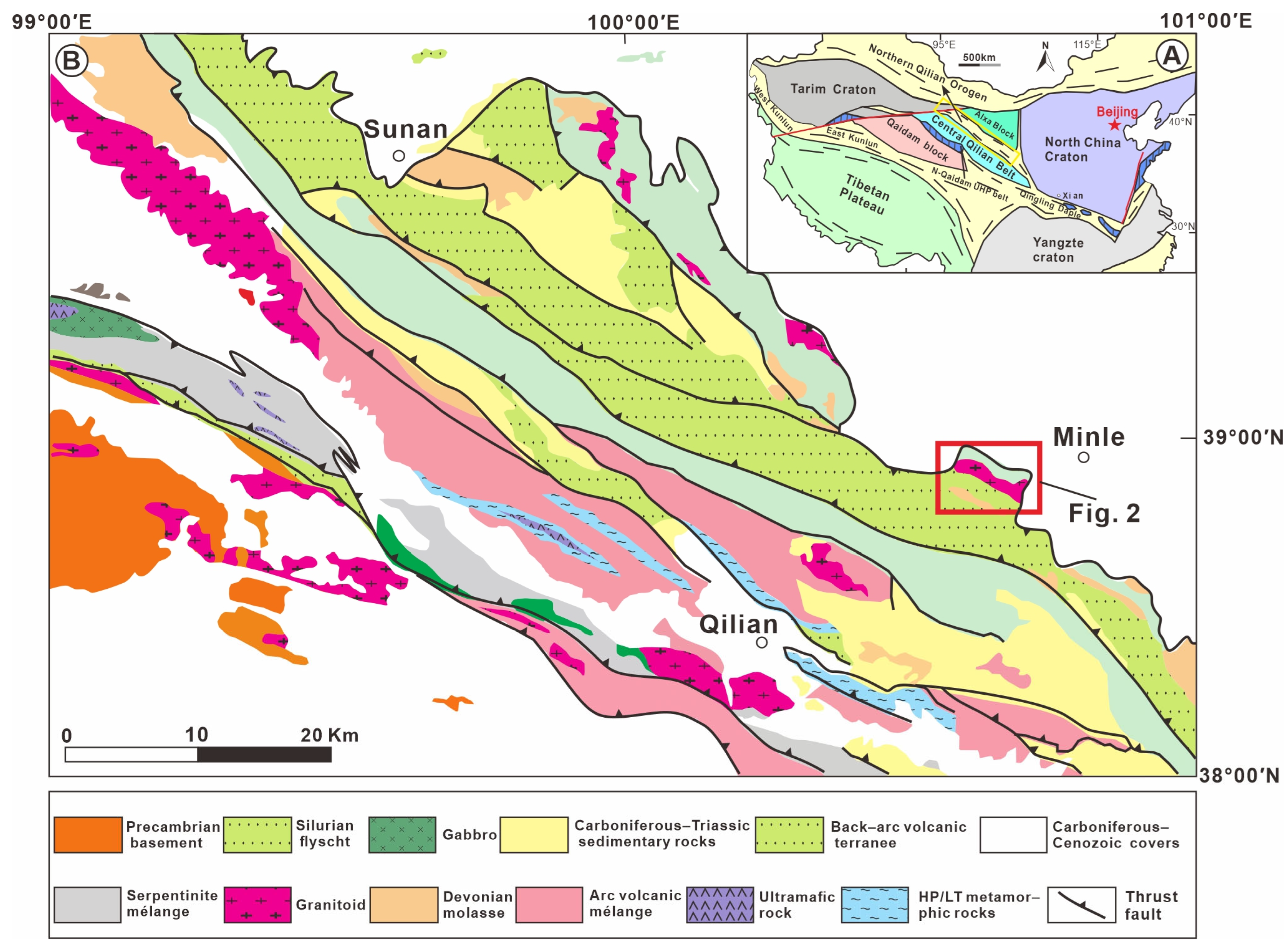
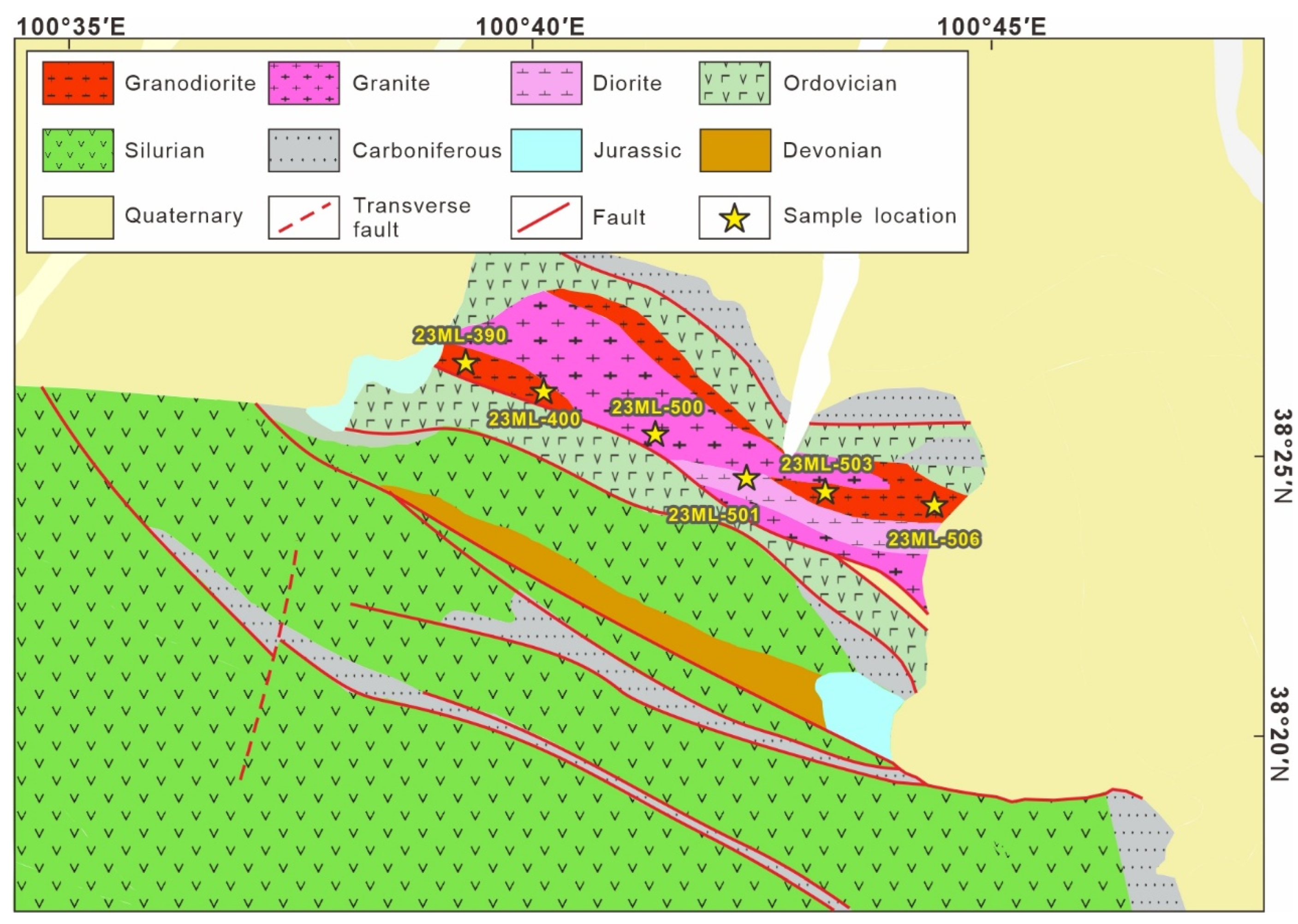

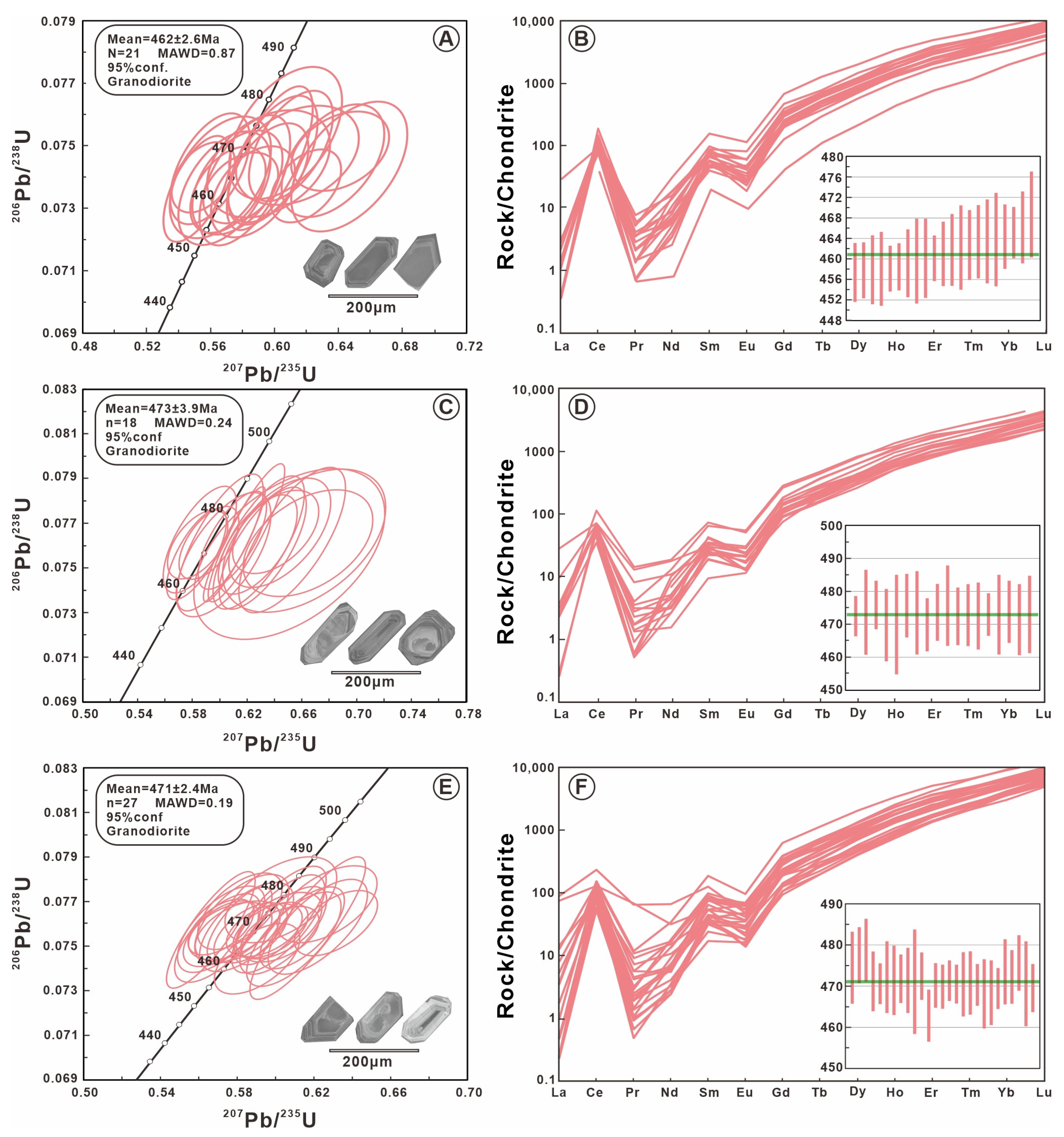





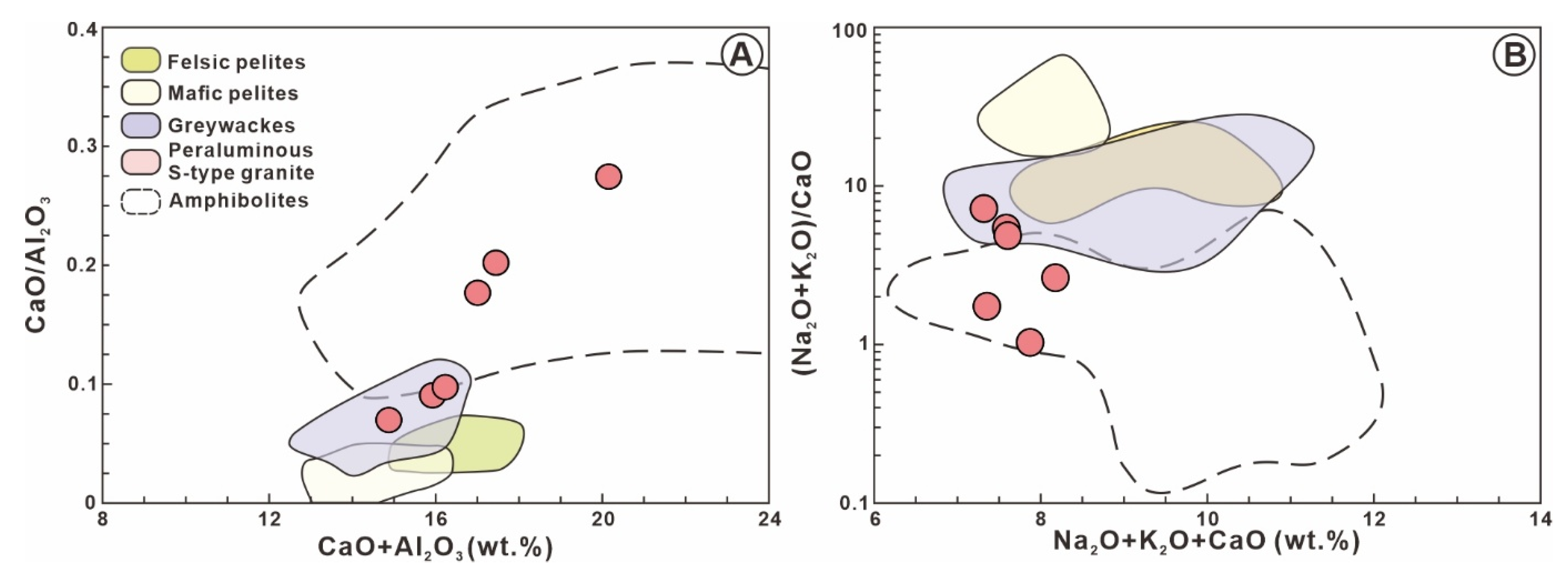


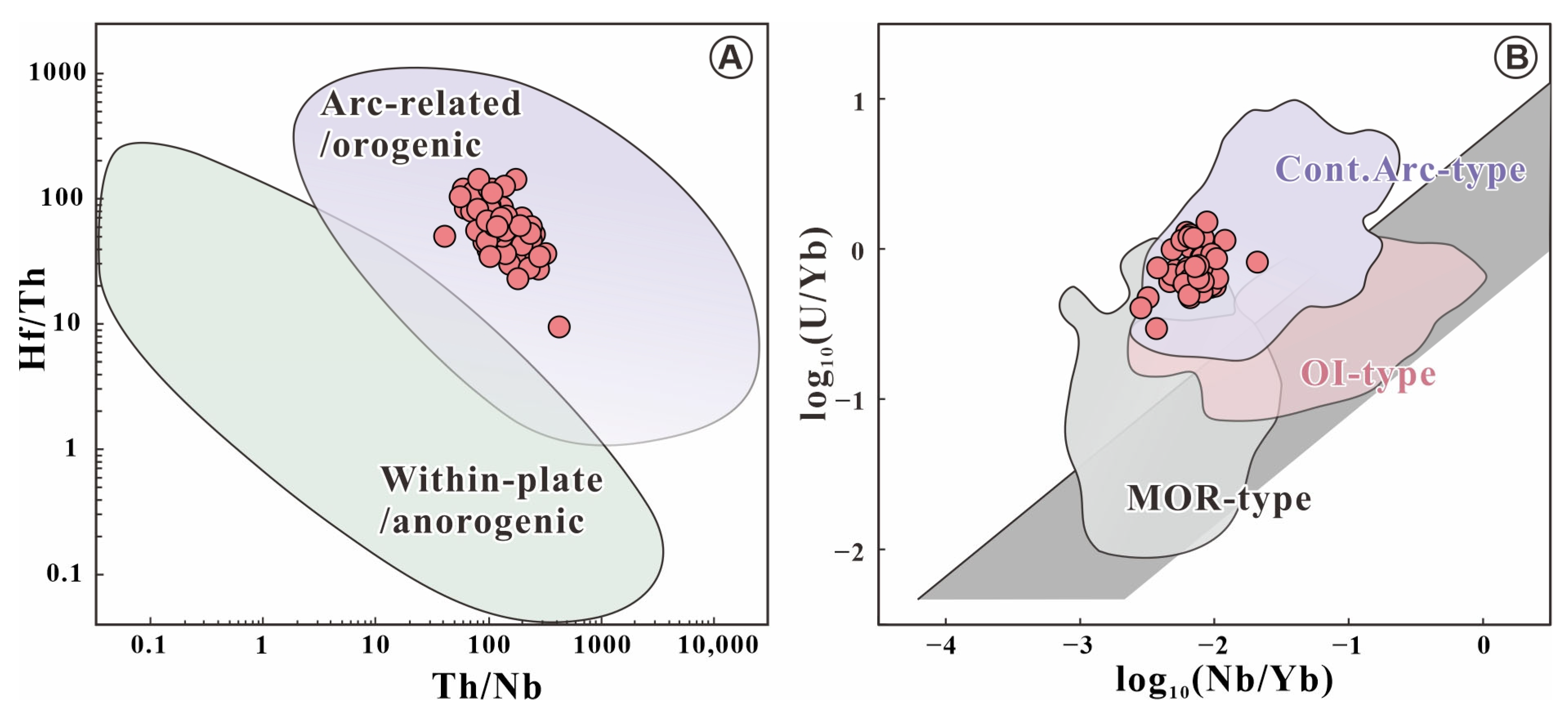

Disclaimer/Publisher’s Note: The statements, opinions and data contained in all publications are solely those of the individual author(s) and contributor(s) and not of MDPI and/or the editor(s). MDPI and/or the editor(s) disclaim responsibility for any injury to people or property resulting from any ideas, methods, instructions or products referred to in the content. |
© 2025 by the authors. Licensee MDPI, Basel, Switzerland. This article is an open access article distributed under the terms and conditions of the Creative Commons Attribution (CC BY) license (https://creativecommons.org/licenses/by/4.0/).
Share and Cite
Li, D.; Yang, Y.; Xiao, Y.; Liu, P.; Liu, X.; Chen, G.; Liu, X.; Hu, R.; Tian, H.; Liu, Y. Petrogenesis and Tectonic Implications of the Early–Middle Ordovician Granodiorites in the Yaogou Area of the North Qilian Orogenic Belt. Minerals 2025, 15, 551. https://doi.org/10.3390/min15060551
Li D, Yang Y, Xiao Y, Liu P, Liu X, Chen G, Liu X, Hu R, Tian H, Liu Y. Petrogenesis and Tectonic Implications of the Early–Middle Ordovician Granodiorites in the Yaogou Area of the North Qilian Orogenic Belt. Minerals. 2025; 15(6):551. https://doi.org/10.3390/min15060551
Chicago/Turabian StyleLi, Dechao, Yang Yang, Yao Xiao, Pengde Liu, Xijun Liu, Gang Chen, Xiao Liu, Rongguo Hu, Hao Tian, and Yande Liu. 2025. "Petrogenesis and Tectonic Implications of the Early–Middle Ordovician Granodiorites in the Yaogou Area of the North Qilian Orogenic Belt" Minerals 15, no. 6: 551. https://doi.org/10.3390/min15060551
APA StyleLi, D., Yang, Y., Xiao, Y., Liu, P., Liu, X., Chen, G., Liu, X., Hu, R., Tian, H., & Liu, Y. (2025). Petrogenesis and Tectonic Implications of the Early–Middle Ordovician Granodiorites in the Yaogou Area of the North Qilian Orogenic Belt. Minerals, 15(6), 551. https://doi.org/10.3390/min15060551





